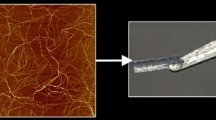Abstract
The reassembly of a half-sequence ionic self-complementarity peptide CH3CO-Pro-Ser-Phe-Cys-Phe-Lys-Phe-Glu-Pro-NH2 was reported, which could self-assemble into stable nanofibers and formed hydrogel consisting of >99% water. In this study, the nanofiber scaffold was sonicated by an ultrasonic cell disruptor. The effects of sonication were detected by circular dichroism (CD), atomic force microscopy (AFM), and rheology. AFM image illustrated that the sonicated fragments could quickly reassemble into nanofibers, while the morphology was distinguishable from the original one. CD spectrum revealed that the conversion occurred mainly between regular β-strand structure and distorted β-strand structure. Rheological analyses showed that the storage modulus (G′) of the peptide solution at the 7th day after sonication decreased by nearly 40% compared with the value of the solution before sonication. Finally, a plausible conversion model was proposed to interpret the reassembly process.
Similar content being viewed by others
References
L Ruan, H Zhang, H Luo, et al. Designed Amphiphilic Peptide Forms Stable Nanoweb, Slowly Releases Encapsulated Hydrophobic Drug, and Accelerates Animal Hemostasis [J]. Proc. Natl. Acad. Sci. USA, 2009, 106(13): 5 105–5 110
A Miyachi, T Takahashi, S Matsumura, et al. Peptide Nanofibers Modified with a Protein by Using Designed Anchor Molecules Bearing Hydrophobic and Functional Moieties[J]. Eur. J. Chem., 2010, 16(22): 6 644–6 650
H Yang, S-Y Fung, M Pritzker, et al. Modification of Hydrophilic and Hydrophobic Surfaces Using an Ionic-Complementary Peptide [J]. PLoS ONE, 2007, 2(12): 1 325–1 327
S Zhang, T C Holmes, C M DiPersio, et al. Self-complementary Oligopeptide Matrices Support Mammalian Cell Attachment [J]. Biomaterials, 1995, 16(18): 1 385–1 393
L P Ruan, H Y Zhang, H L Luo, et al. Application Research of a Novel Designed Peptide as a Potential Carrier [J]. Sci. China Ser. B-Chem., 2009, 52(5): 632–638
E Genove, C Shen, S Zhang, et al. The Effect of Functionalized Selfassembling Peptide Scaffolds on Human Aortic Endothelial Cell Function [J]. Biomaterials, 2005, 26(16): 3 341–3 351
X Wang, L Qiao, A Horii. Screening of Functionalized Self-assembling Peptide Nanofiber Scaffolds with Angiogenic Activity for Endothelial Cell Growth [J]. Progress in Natural Science: Materials International, 2011, 21(2): 111–116
N L Ngoc, K Takaomi. Ultrasound Stimulus Effect on Hydrogen Bonding in Networked Alumina and Polyacrylic Acid Surry [J]. Ultrason. Sonochem., 2010, 17(1): 186–192
Y Li, T Wang, M Liu. Ultrasound Induced Formation of Organogel from a Glutamic Dendron[J]. Tetrahedron, 2007, 63(31): 7 468–7 473
C Marchioni, E Riccardi, S Spinelli, et al. Structural Changes Induced in Proteins by Therapeutic Ultrasounds [J]. Ultrasonics, 2009, 49(6-7): 569–576
L P Ruan, H L Luo, H Y Zhang, et al. Investigation on Structure and Properties of a Novel Designed Peptide with Half-Sequence Ionic Complement [J]. Macromol. Res., 2009, 17(8): 597–602
J H Seo, R Matsuno, Y Lee, et al. Conformational Recovery and Preservation of Protein Nature from Heat-induced Denaturation by Water-soluble Phospholipid Polymer Conjugation[J]. Biomaterials, 2009, 30(28): 4 859–4 867
H Yokoi, T Kinoshita, S Zhang. Dynamic Reassembly of Ppeptide RADA16 Nanofiber Scaffold[J]. Proc. Natl. Acad. Sci. USA, 2005, 102(24): 8 414–8 415
X Cao, Y Li, S Jiang, et al. A Study of Dilational Rheological Properties of Polymers at Interfaces[J]. J. Colloid. Interface. Sci., 2004, 270(2): 295–298
M M Eugenia, N R Martan, D Giacomazza, et al. Correlation between Rheological Properties and Limonene Release in Pectin Gels using an Electronic Nose [J]. Food Hydrocoll., 2008, 22(5): 916–924
S L Hem. The Effect of Ultrasonic Vibrations on Crystallization Processes [J]. Ultrasonics, 1967, 5(4): 202–207
B Torok, K Balazsik, K Felfoldi, et al. Asymmetric Reactions in Sonochemistry [J]. Ultrason. Sonochem., 2001, 8(3): 191–200
H Li, J Wang, Y Bao, et al. Rapid Sonocrystallization in the Saltingout Process [J]. J. Cryst. Growth, 2003, 247(1-2): 192–198
Author information
Authors and Affiliations
Corresponding author
Additional information
Funded by the National Natural Science Foundation of China (No. 51003065) and New Teachers’ Fund for Doctor Stations, Ministry of Education (No. 20100181120077)
Rights and permissions
About this article
Cite this article
Ruan, L., Luo, H., Zhang, H. et al. Effect of sonication on a novel designed peptide. J. Wuhan Univ. Technol.-Mat. Sci. Edit. 28, 622–626 (2013). https://doi.org/10.1007/s11595-013-0741-2
Received:
Accepted:
Published:
Issue Date:
DOI: https://doi.org/10.1007/s11595-013-0741-2




